Labor's Gotta Play
Hardball to Win!
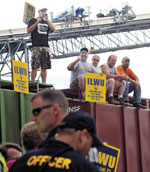
Showdown on West Coast Docks: The Battle of Longview
(November 2011).
click on photo for article
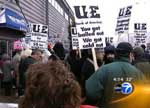
Chicago Plant Occupation Electrifies Labor
(December 2008).
click on photo for article

May Day Strike Against the War Shuts Down
U.S. West Coast Ports
(May 2008)
click on photo for article

October 2021
For Labor
Solidarity Action to
Win the UAW John Deere
Strike!
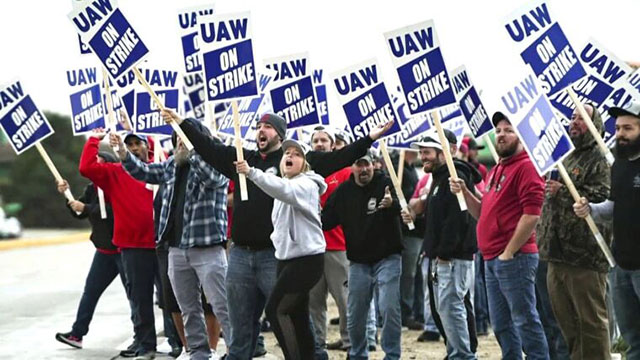
Striking John Deere workers outside the Davenport (Iowa) Works on the first day of the strike, October 14. (Photo: NBC)
At midnight October 14, more than 10,000 John Deere workers walked off the job at the world’s largest agricultural equipment manufacturing company. A total of 14 plants represented by the United Auto Workers (UAW) were struck, including eleven in Iowa and Illinois, as well as facilities in Colorado, Georgia and Kansas. It is the first time the union has struck Deere in 35 years. As labor strikes are spreading in the U.S., the walkout at Deere is the biggest this year, and the largest nationwide since the six-week UAW strike at General Motors in 2019.
The strikers are in a strong position. Deere is on track to reap a projected $5.9 billion in profits this year, far higher than the $3.5 billion of its previous record year of 2013. Sales are booming as soybean and corn prices skyrocket and farmers’ demand for equipment is high. It’s harvest time, when equipment breaks down and replacements are needed fast. And workers are fighting mad after laboring right through the pandemic as “essential workers,” risking their lives, while Deere bosses are raking it in. (CEO John May got nearly $16 million in salary last year.)
Workers are angry, too, at union leaders for giving in to the company. On October 10, over 90% of Deere workers voted to reject a tentative agreement negotiated by the UAW and Deere management and to go on strike. That deal would have included paltry wage increases of 11-12% over six years – barely 2% a year – at a time when inflation is running at over 4% annually. In other words, a pay cut. Explaining the huge “no” vote, a veteran worker told the Des Moines Register (11 October), “We busted our [expletive]…. We got crumbs.”
The Register reported that outside the voting site in Des Moines there were signs reading “Reject this Piece of Trash” and “Vote No, You Deserve Better.” A video from Waterloo, Iowa showed workers booing a UAW International representative. In East Moline, Illinois, another video showed workers asking union reps why they didn’t call a strike after the membership authorized one in September. “You didn't hear us,” she said. “Do you hear us now?... We deserve better.”
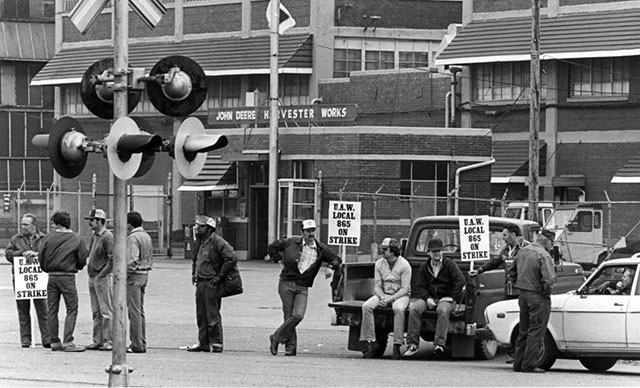
The 1986 John Deere strike (above, at the Harvester Works in East Moline, IL), lasted 163 days. (Photo: The Daily Nonpareil [Council Bluffs, Iowa])
This is the first strike at Deere since the 163-day battle in 1986, at the end of the farm crisis which led to the bankruptcies of many small family farmers. At that time, a selective strike by the union was turned into a lockout by the bosses. Today Deere is playing hardball again, harassing workers. The London Guardian (14 October) quoted one saying, “They have put highly paid managers on certain [machine] operators to watch them and just bird dog them all day.” But today, particularly with rampant labor shortages, the union is in a good position to fight back.
John Deere workers aren’t the only ones being thrown under the tractor as profit-gouging companies aim to speed up production and maximize profits as the COVID-19 pandemic grinds on. In Topeka, Kansas, 600 Frito-Lay workers struck for three weeks in July over pay, forced overtime and workweeks of up to 84 hours. Nabisco workers waged a six-week-long strike in August and September, among other issues over not-so “voluntary” 12-hour weekend shifts. And on October 5, some 1,400 Kellogg’s workers walked out over plans to expand a tier system in which newer workers are paid $11/hour less than senior workers.
At Deere, the tentative agreement that union tops signed on to would have introduced a third tier in retirement plans. In 1997, they agreed to a second tier, in which workers hired after that date received only one-third the pension that previous workers got. Under the rejected TA, new hires would not get a pension at all but a 401(k) plan with no defined benefits. A woman worker at the Ankeny, Iowa plant commented, “John Deere’s been a bully since ’97, on the playground with the UAW. They bullied the UAW around and got away with it. It’s time we stood up.”
Introducing tiers divides younger and older workers and weakens the unions. A Washington Post (29 August 2018) article titled, “How two-tier unions turn workers against one another,” spelled out how implementing a tier system “ultimately succeeded in rolling back autoworkers' living standards, opening the door for many more such concessions in the years to come. Other employers were watching closely, as the auto industry was a central node in the U.S. economy and a strategic center for union power. As went the auto industry, so went the nation.”
Class-conscious workers at Deere should not only oppose the third tier the company wants to impose, they should demand an end to the tier system altogether. But that won’t be won by a routine “one-day-longer, one-day-stronger” strike that drags on and on – it will take hard class struggle. And after decades of the union tops caving in to the bosses’ offensive, unrest is building. As Esquire (15 October) noted: “organized labor [is] getting extraordinarily restive in a way we haven’t seen since Ronald Reagan broke PATCO” air traffic controllers’ strike in 1981.
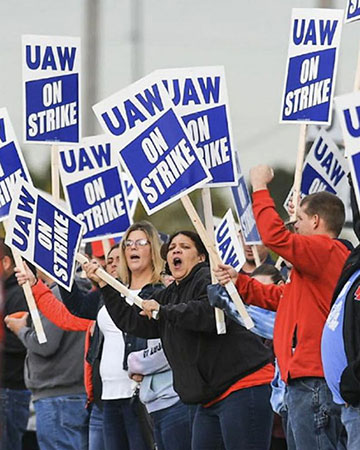 To win the strike, shut
down production. Build picket lines so big and militant
that nobody dares cross. (Photo:
ABC News)
To win the strike, shut
down production. Build picket lines so big and militant
that nobody dares cross. (Photo:
ABC News)Supporters of labor everywhere are watching the Deere strike closely, and strikers know it. Now is the time to fight to take back the givebacks that have been bargained away over four decades. As the company moves to bring in scab labor, it’s using white-collar salaried employees to perform dangerous machinist and welding jobs they’re not qualified to handle, with potentially disastrous results. Many have expressed sympathy for the strike. What needs to happen is to stop production totally by building mass picket lines so big and militant that no one dares cross!
That requires real labor solidarity action. The Quad Cities area including Davenport and Bettendorf, Iowa and Rockport, Moline and East Moline, Illinois is a big manufacturing hub: let every plant send a delegation. And not just workers. U of I students in Iowa City are an hour away, and UNI is right there in Waterloo. In Ottumwa, the JBS meatpacking plant has a tradition of solidarity going back to the 1985 Hormel P-9 strike. As restaurants provide strikers free food and stores give discounts, there is plenty of community support. Let’s mobilize it!
Teamsters and rail workers must refuse to cross the picket lines. And all Deere manufacturing operations should be shut down. The 1986 strike began at the Horicon works plant in Wisconsin, which makes lawn tractors and smaller utility vehicles. The 800 Deere workers there, organized by IAM (Machinists) Local 873, have pledged support. So strikers could dispatch a flying squad to picket them out. And union militants should demand an elected strike committee, to mobilize the members and oppose a repeat of the bureaucratic sellout.
The industrial unions were built in the 1930s with sit-down strikes, plant occupations, “hot cargoing” struck goods and other class-struggle tactics, all led by “reds.” The Minneapolis Teamster strikes of 1934, led by Trotskyists, shut down the city and faced down the National Guard. They showed that a mobilized working class can “fight the government” and prevail. All this underlines the need for a fighting leadership with a program and determination to take on the capitalist system as a whole.
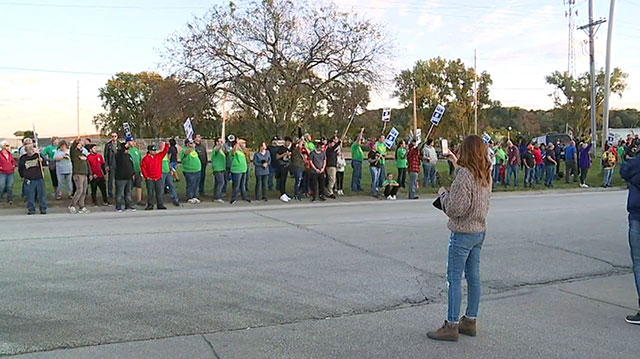
Striking Deere workers and supporters outside the Harvester Works in East Moline, October 19. (Photo: WQAD)
The John Deere strikers can win, and win big, so long as they don’t play by the bosses’ rules. A victory in this class battle will encourage workers everywhere, ground down by brutal working conditions and pay that amounts to crumbs while the owners walk off with millions. The COVID pandemic opened a lot of people’s eyes. Many have seen that capitalism can’t provide the basic needs of the population, as hundreds of thousands have died while the deadly plague spread, and the profit-gouging capitalists cashed in. The John Deere strikers experienced this directly.
Workers must look to exercise their own power – through labor solidarity and alliance with all those oppressed in this society based on ruthless exploitation – understanding that the Democratic Party, no less than the Republicans, defends the interests of capital. Republicans act as direct mouthpieces for the corporations, while the Democrats – even some like Bernie Sanders, who calls himself a “socialist” and scored big in Davenport in the 2020 Democratic primaries – pose as “friends of labor” to get votes, suppress labor militancy and maintain the capitalist order.
The union bureaucracy that pushes sellout contracts, like the one voted down at Deere, is tied to the Democratic Party by an umbilical cord. What’s sorely needed is a class-struggle leadership of the unions. This poses the need to forge a workers party, independent of and against all the bosses’ parties, to lead all the oppressed in the fight for a workers government, in which those who labor shall rule. The Deere workers’ fight is the fight of working people everywhere. We’re all in it together. Victory to the UAW John Deere Strike! ■
Beware of the “World Scab Web Site”
An outfit calling itself the World Socialist Web Site has shown up at a number of strikes and labor struggles around the country posing as leftists while denouncing unions. This bunch is neither left-wing nor socialist, but instead are acting as auxiliaries of the bosses. In Bessemer, Alabama the WSWS told Amazon workers to vote against a union. Don’t be taken in by these phonies. Genuine socialists have always been in the forefront of building unions and union struggle. The anti-union WSWS also serves the bosses by helping to discredit genuine socialists. They have no business being on a union picket line.